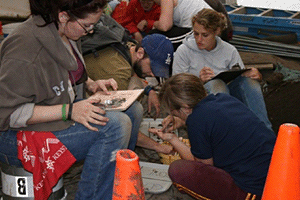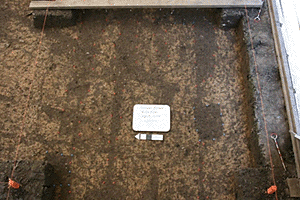
Prosser button

Slice of minié ball
For the first week of excavating in the prison hospital, we divided into two teams of four working in two 2 m2 units excavating the plow zone, the upper level of soil, disturbed by plowing but still containing artifacts. Our most common finds included nineteenth-century ceramics and glass, cut nails, brick, and flint pieces (from earlier, Native American occupations). We uncovered numerous field specimens–artifacts recorded separately because of their special significance–such as embossed glass, bottle finishes, and ceramic rim pieces. Among the most interesting were Prosser buttons, a table knife fragment, a door hinge, and a slice of a minié ball (a common type of bullet, named after a French army officer). While these special discoveries are always exciting, the more frequently found artifacts can actually tell us more about the history and the daily life of the prison. For instance, window glass and nails can help pinpoint structural elements of buildings such as windows, while medical bottle and bedpan fragments reflect life inside the hospital.

Students recording the finds from a unit
Johnson’s Island is considered a multi-component site. Not only is there the evidence of the Civil War Prison, but we are also finding evidence of Native American occupations back thousands of years. Just in the first week we have found various types of flint and chert flakes, indicative of tool manufacture, as well as prehistoric pottery sherds. Although this is not the research focus of Dr. Bush, these materials are also recovered and studied.
Now, we have moved on to the more strenuous and exacting practice of excavating from the plow zone to the subsoil, looking for features like plow scars and postholes. We use laser transits and meter sticks to assist us in keeping the unit’s floor at the same level. We have trained ourselves to be diligent measurers, making sure we keep the unit level. It is important to keep the floor of the unit level to identify the features that we see in the subsoil.

Students screening soils
Things that surprised us this first week include how much material seemed to fall through the cracks of the prison hospital. Finding hundreds of artifacts in each 2 m2 unit shows that the floors were not that sealed and that use by hundreds of prisoners over the course of 40 months has left its mark. Were the doctors and nurses (typically other prisoners served as nurses) careless, or does this just reflect how things were?
Josselyn, a former Helix student who had worked at the site for a week in 2000, recalled how much the features showed up in the subsoil. Many of us had no idea that these features were present there and what excavation procedures were necessary to make sure this evidence of the past could be recorded.

Subsurface features beginning to show up in the level
We thought that the prisoners would have only minimal items for their survival, but as Megan noted, “I was surprised how much really nice stuff they had.” We were also surprised that the prisoners complained about their conditions, even though they seemed to have ample food and other materials.
Dave W. and others of us found that the readings from prisoners’ diaries every day helped to understand just how important the prison was to the war. Hearing about how the prisoners tried to escape and the attempt by the Confederates to free the prisoners in September 1864 are things that Dave never knew, even though he lived at Oak Harbor, only 20 miles away, all his life.

Theresa, Dave, and Josselyn writing up field notes
Allison was amazed that anyone in the hospital got better considering how primitive medical treatment was at that time. We have discovered evidence of the medicines they used, and most were just alcohol-based mixtures.
All of us are curious if the prisoners had to deal with the snakes, spiders, mice that we deal with every day. Every time we uncover the units, we can expect to see mice scatter and at least one snake slither its way out of the tent. Still, after the first week, we can honestly say the blisters from the work and the slight sun poisoning that Theresa has is all worth it!

